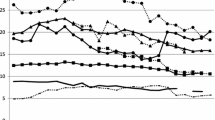Abstract
This paper examines the suicide rates of 23 cities and counties in Taiwan from 1983 to 2001. We found that a combination of economic and social variables can significantly account for the tremendous variations in suicide rates across Taiwan’s cities and counties over the last two decades. The level of income per capita in a region appears as the most important predictor of suicide rates. However, some sociological correlates (such as divorce rate) which were less powerful in explaining suicide rate variations in the earlier study appear to exert more significant influence over suicide rates when eight more recent years of information are added, as in the current study. This study also uncovered several gender differences in the determination of regional suicide rates, such as the proportion of elderly population in the region, and the impacts of earthquake and unemployment. Furthermore, this study confirmed the linkages between natural disaster (earthquake) and suicide, between economic and social miseries (unemployment and divorce, respectively) and suicide, as well as those between demographics (aboriginal and elderly sub-population groups) and suicide. This may help to identify high-risk groups or areas where suicide prevention and intervention efforts should be concentrated on or directed to. Lastly, the local suicide crisis-intervention agencies are found to be significantly effective in reducing suicide rates of the community they serve.
Similar content being viewed by others
References
Brenner M. (1983) Mortality and economic instability. International Journal of Health Services 13:563–620
Burr J., McCall P., Powell-Griner E. (1997) Female labor force participation and suicide. Social Science & Medicine 44:1847–1859
Chang P. (1988) Tzu sha yuen yin lunn [The Causes of Suicide]. Taipei: Wu Nan Publisher
Chuang H., Huang W. (1997) Economic and social correlates of regional suicide rates: A pooled cross-section and time-series analysis. Journal of Socio-Economics 26:277–289
De Leo D., Carollo G., Dello Buono M. (1995) Lower suicide rates associated with a Tele-Help/Tele-Check service for the elderly at home. The American Journal of Psychiatry 152:632–634
Durkheim, E.: 1951, Suicide: A Study in Sociology, translated by J.A. Spaulding and G.␣Simpson (Free Press, Glencoe, IL)
Ferrada-Noli M., Asberg M. (1997) Psychiatric health, ethnicity and socioeconomic factors among suicides in Stockholm. Psychological Reports 81:323–332
Hamermesh D., Soss N.M. (1974) An economic theory of suicide. Journal of Political Economy 82:83–98
Hausman J.A. (1978) Specification tests in econometrics. Econometrica 46:1251–1271
Hsiao, C.: 1986, Analysis of Panel Data. Econometric Society Monograph No. 11 (Cambridge University Press, Cambridge)
Hsieh C., Liu B. (1983) The pursuance of better quality of life in the long run, better quality of social life is the most important factor in migration. American Journal of Economics and Sociology 42:431–440
Johansson L., Sundquist J. (1997) Unemployment is an important risk factor for suicide in Sweden. Public Health 111:41–45
Leenars A., Yang B., Lester D. (1993) The effect of domestic and economic stress on suicide rates in Canada and the United States. Journal of Clinical Psychology 49:918–921
Lester D. (1988) A regional analysis of suicide rates in the U.S. Social Psychiatry and Psychiatric Epidemiology 23:202–205
Lester D. (1997a) Anxiety, economic growth, and suicide and homicide. Perceptual and Motor Skills 85:382
Lester D. (1997b) The effectiveness of suicide prevention centers. Suicide and Life Threatening Behavior 27:304–310
Lester D. (2000) Why People Kill Themselves, 4 Springfield, IL: Charles Thomas
Lester D., Yang B. (1991) Microsocionomics versus macrosocionomics as a model for examining suicide. Psychological Reports 69:735–738
Li G. (1995) The interaction effect of bereavement and sex on the risk of suicide in the elderly. Social Science & Medicine 40:825–828
Liu B. (1980) Differential net migration rates and the quality of life: A reply with additional evidence. Review of Economics and Statistics 62:160–162
Luoma J., Pearson J. (2002) Suicide and marital status in the United States,1991–1996: is widowhood a risk factor? American Journal of Public Health 92:1518–1522
Marcotte D. (2003) The economics of suicide, revisited. Southern Economic Journal 69:628–643
Norstrom T. (1995) The impact of alcohol, divorce, and unemployment on suicide: A multilevel analysis. Social Forces 74:293–314
Platt S., Micciolo R., Tansella M. (1992) Suicide and unemployment in Italy. Social Science & Medicine 34:1191–1201
Schapiro M., Ahlburg D. (1983) Suicide: the ultimate cost of unemployment. Journal of Post Keynesian Economics 5:277–280
Stack S. (1992) The effect of divorce on suicide in Finland: a time series analysis. Journal of Marriage and Family 54:636–642
Stack S. (1997) The effect of labor force participation on female suicide rates. Omega 34:163–169
Studenmund A.H. (2006) Using Econometric, A Practical Guide. New York: Pearson Education, Inc
Taylor S. (1982) Durkheim and the Study of Suicide. New York: St. Martin’s
Warheit G., Zimmerman R., Khoury E. (1996) Disaster related stresses, depressive signs and symptoms, and suicidal ideation among a multi-racial/ethnic sample of adolescents: A longitudinal analysis. The Journal of Child Psychology and Psychiatry and Allied Disciplines 37:435–444
Wasserman I. (1984) A longitudinal analysis of the linkage between suicide, unemployment, and marital dissolution. Journal of Marriage and Family 46:853–859
Yang B. (1992) The economy and suicide: a time-series study of the U.S.A. American Journal of Economics and Sociology 51:87–99
Yang B., Lester D. (1995) Suicide, homicide, and unemployment. Applied Economics Letters 2:278–279
Yip P. (1998) Age, sex, marital status and suicide: An empirical study of East and West. Psychological Reports 82:311–322
Acknowledgements
We thank the National Science Council of Taiwan ROC for financial support, and Ms. S. Yang for her skillful research assistance. The authors are grateful to the anonymous referee for comments and suggestions which improved the quality of this paper.
Author information
Authors and Affiliations
Corresponding author
Rights and permissions
About this article
Cite this article
Chuang, HL., Huang, WC. A Re-Examination of the Suicide Rates in Taiwan. Soc Indic Res 83, 465–485 (2007). https://doi.org/10.1007/s11205-006-9056-4
Received:
Accepted:
Published:
Issue Date:
DOI: https://doi.org/10.1007/s11205-006-9056-4




